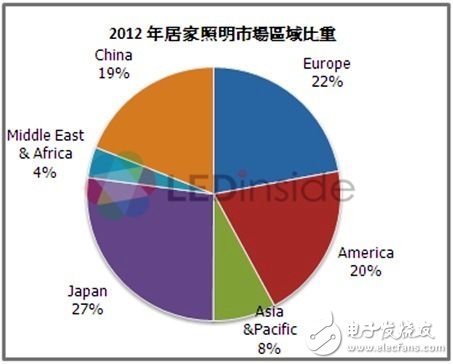LEDinside, the green energy business unit of TrendForce, a global market research organization, published a new market report that pointed out that from 2012 to 2014, with the gradual fermentation of the banned incandescent lamps in various regions, LED lamps began to enter the home lighting market. Because of the increase in luminous efficiency and the decline in the price of LED lamps, consumer acceptance has gradually increased, and the penetration rate of LED lighting has also increased. In 2012, Japan's LED home lighting market was still the largest in Japan, followed by Europe and North America; however, China's proportion is also increasing year by year. By 2013, the home lighting market in China will reach US $ 5.941 billion, of which the LED home lighting market will reach US $ 814 million, accounting for 24% of the global total. In other regions such as Europe, America, Japan, Taiwan and emerging markets, policy standards have been introduced and manufacturers' active product and price strategies are also rapidly promoting the development of the LED home lighting market. The LED home lighting market in North America has benefited from the increasing number of new home sales and the arrival of the sweet spot in the retail price of LED bulbs. Home lighting plus energy star and other lamp specifications have also pushed the market toward standardized development. First-tier manufacturers are eyeing the business opportunities in the North American market. Cree, GE, Philips and other major manufacturers have launched new products with low prices or high performance to seize the market share. The European LED lighting market is affected by the comprehensive white ban policy. Competition is becoming more and more fierce. The average price of LED light bulb products continues to fall. More and more smart LED light bulb products enter the market. LED bulbs, Osram (Osram) also uses its lighting control system company to widely integrate LED lighting with smart control systems. Proportion of home lighting market by region In 2012, the number of LED bulbs shipped in Japan reached 27.9 million, and it is estimated that it will grow to 28.5 million in 2013. Due to the fierce price competition and saturation in the bulb market, Japanese lighting manufacturers have formulated new future development strategies, such as market segmentation with high-wattage replacement or high-performance bulbs, development of ceiling lamps and other lamp markets, or expansion of Vietnam and Taiwan And other overseas emerging markets. In 2013, the number of financial subsidies for semiconductor lighting in China will expand to 30 million, and home lighting products will be included in the scope. However, according to the survey of LEDinside Chinese consumers ’awareness of LED lamps, the general public ’s awareness of LED lighting is still at a low level, and the number of people who can correctly identify LED bulbs is only 25% . Therefore, China's LED lighting still needs adequate consumer education to open the ordinary household market, so that ordinary household consumers have a fuller and more comprehensive understanding of LED lights. According to an LEDinside survey, Taiwan ’s LED bulbs shipped 1.34 million units in 2012, and it is estimated that it will grow 20% to 1.608 million units in 2013. Major manufacturers include Everlight, Delta, Taiyi, etc. In addition, Toshiba and Philips are actively expanding the Taiwan market by introducing new lamp specifications. Beam Splitter,Dichroic Beam Splitter,Optical Beam Splitter Cube,Beam Splitter Cube Danyang Horse Optical Co., Ltd , https://www.dyhorseoptical.com